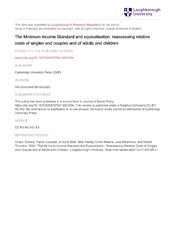The Minimum Income Standard and equivalisation Reassessing relative costs of singles and couples and of adults and children
Issued: February 2020
Summary
The MESL research contributed to this journal article examining equivalence scales.
Equivalence scales, used to compare incomes across household types, strongly influence which households have low reported income, affecting public policy priorities. Yet they draw on abstract, often dated evidence and arbitrary judgements, and on comparisons across the income distribution rather than focusing on minimum requirements. Budget standards provide more tangible comparisons of the minimum required by different household types. The Minimum Income Standard (MIS) method, now established in several countries, applies a common methodological framework for compiling budgets, based on public deliberations. This article draws for the first time on results across countries. In all of the four countries examined, it identifies an under-estimation by the OECD scale of the relative cost of children compared to adults, and in three of the four, an under-estimation of the cost of singles compared to couples. This more systematically corroborates previous, dispersed evidence, and helps explain which specific expenditure categories influence these results. These results have high policy relevance, showing greater proportions of low income households to contain children than standard income distribution data. While no single equivalence scale can be universally accurate, making use of evidence based directly on benchmarks such as MIS can help inform public priorities in tackling low income.
This article has been published in a revised form in Journal of Social Policy https://doi.org/10.1017/S0047279419001004. This version is published under a Creative Commons CC-BY-NC-ND. No commercial re-distribution or re-use allowed. Derivative works cannot be distributed. © CambridgeUniversity Press
